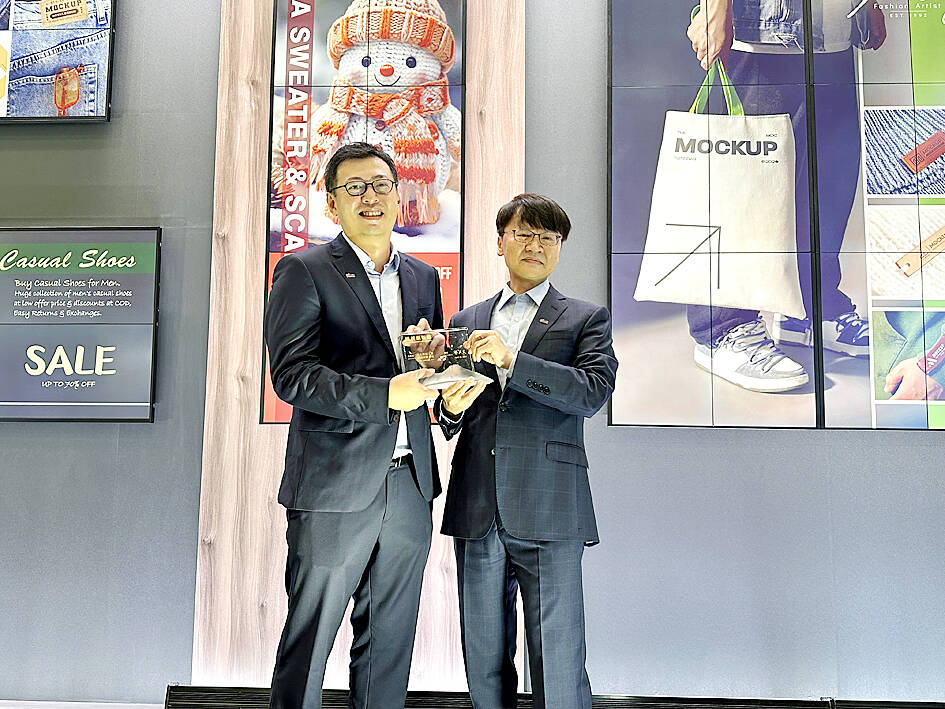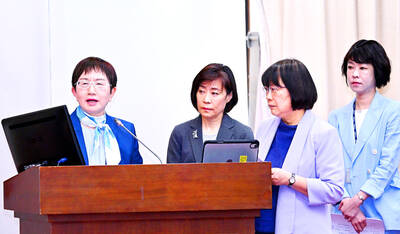E Ink Holdings Inc (元太科技), the world’s largest e-paper display supplier, yesterday reported a 25 percent annual decline in net profit for last quarter as a bumpy transition to better color displays for electronic shelf labels (ESLs) led to a supply chain glut.
Module customers were still grappling with excessive inventory last month, leading to a decline in the company’s Internet of Things (IoT) business, which primarily produces ESL e-paper displays, E Ink said.
Net profit sank to NT$1.32 billion (US$40.9 million) during the three months to March, from NT$1.76 billion over the same period last year. Earnings per share dropped to NT$1.16 from NT$1.54.

Photo: Chen Mei-ying, Taipei Times
Operating profit plunged 54 percent annually to NT$833 million from NT$1.81 billion, but non-operating income grew 95 percent to NT$879 million, including foreign exchange gains of NT$497 million, helping to bolster the firm’s bottom line, E Ink said.
“Looking forward, the IoT business will return to the normal growth path in the third quarter and that growth will extend into the fourth quarter,” E Ink chairman Johnson Lee (李政昊) told investors at a quarterly conference yesterday, adding that the firm’s downstream partner, Walmart Inc, plans to implement its ESL installment project at the end of this year, ahead of schedule.
Regarding e-paper displays for e-readers, growth momentum is robust and better than expected, indicating a smooth switch to color e-readers from black and white, Lee said.
E Ink has noticed that supply of new colored e-paper displays made on Kaleido 3 technology is constrained, he said.
The company retains its positive outlook for this year, expecting revenue to grow every quarter going forward, he said.
“The most important thing is that we have at least ridden through the trough period,” Lee said. “The second quarter is better than the first quarter, and we believe the third quarter will be better than the second.”
E Ink said that it has expanded capacity to produce large e-paper displays for digital signage used in retail stores or for outdoor advertising, and expects to ramp up production by the end of this year.
The firm said it has budgeted NT$5 billion to NT$6 billion of capital expenditure for this year.

‘SWASTICAR’: Tesla CEO Elon Musk’s close association with Donald Trump has prompted opponents to brand him a ‘Nazi’ and resulted in a dramatic drop in sales Demonstrators descended on Tesla Inc dealerships across the US, and in Europe and Canada on Saturday to protest company chief Elon Musk, who has amassed extraordinary power as a top adviser to US President Donald Trump. Waving signs with messages such as “Musk is stealing our money” and “Reclaim our country,” the protests largely took place peacefully following fiery episodes of vandalism on Tesla vehicles, dealerships and other facilities in recent weeks that US officials have denounced as terrorism. Hundreds rallied on Saturday outside the Tesla dealership in Manhattan. Some blasted Musk, the world’s richest man, while others demanded the shuttering of his

ADVERSARIES: The new list includes 11 entities in China and one in Taiwan, which is a local branch of Chinese cloud computing firm Inspur Group The US added dozens of entities to a trade blacklist on Tuesday, the US Department of Commerce said, in part to disrupt Beijing’s artificial intelligence (AI) and advanced computing capabilities. The action affects 80 entities from countries including China, the United Arab Emirates and Iran, with the commerce department citing their “activities contrary to US national security and foreign policy.” Those added to the “entity list” are restricted from obtaining US items and technologies without government authorization. “We will not allow adversaries to exploit American technology to bolster their own militaries and threaten American lives,” US Secretary of Commerce Howard Lutnick said. The entities

Minister of Finance Chuang Tsui-yun (莊翠雲) yesterday told lawmakers that she “would not speculate,” but a “response plan” has been prepared in case Taiwan is targeted by US President Donald Trump’s reciprocal tariffs, which are to be announced on Wednesday next week. The Trump administration, including US Secretary of the Treasury Scott Bessent, has said that much of the proposed reciprocal tariffs would focus on the 15 countries that have the highest trade surpluses with the US. Bessent has referred to those countries as the “dirty 15,” but has not named them. Last year, Taiwan’s US$73.9 billion trade surplus with the US

Prices of gasoline and diesel products at domestic gas stations are to fall NT$0.2 and NT$0.1 per liter respectively this week, even though international crude oil prices rose last week, CPC Corp, Taiwan (台灣中油) and Formosa Petrochemical Corp (台塑石化) said yesterday. International crude oil prices continued rising last week, as the US Energy Information Administration reported a larger-than-expected drop in US commercial crude oil inventories, CPC said in a statement. Based on the company’s floating oil price formula, the cost of crude oil rose 2.38 percent last week from a week earlier, it said. News that US President Donald Trump plans a “secondary